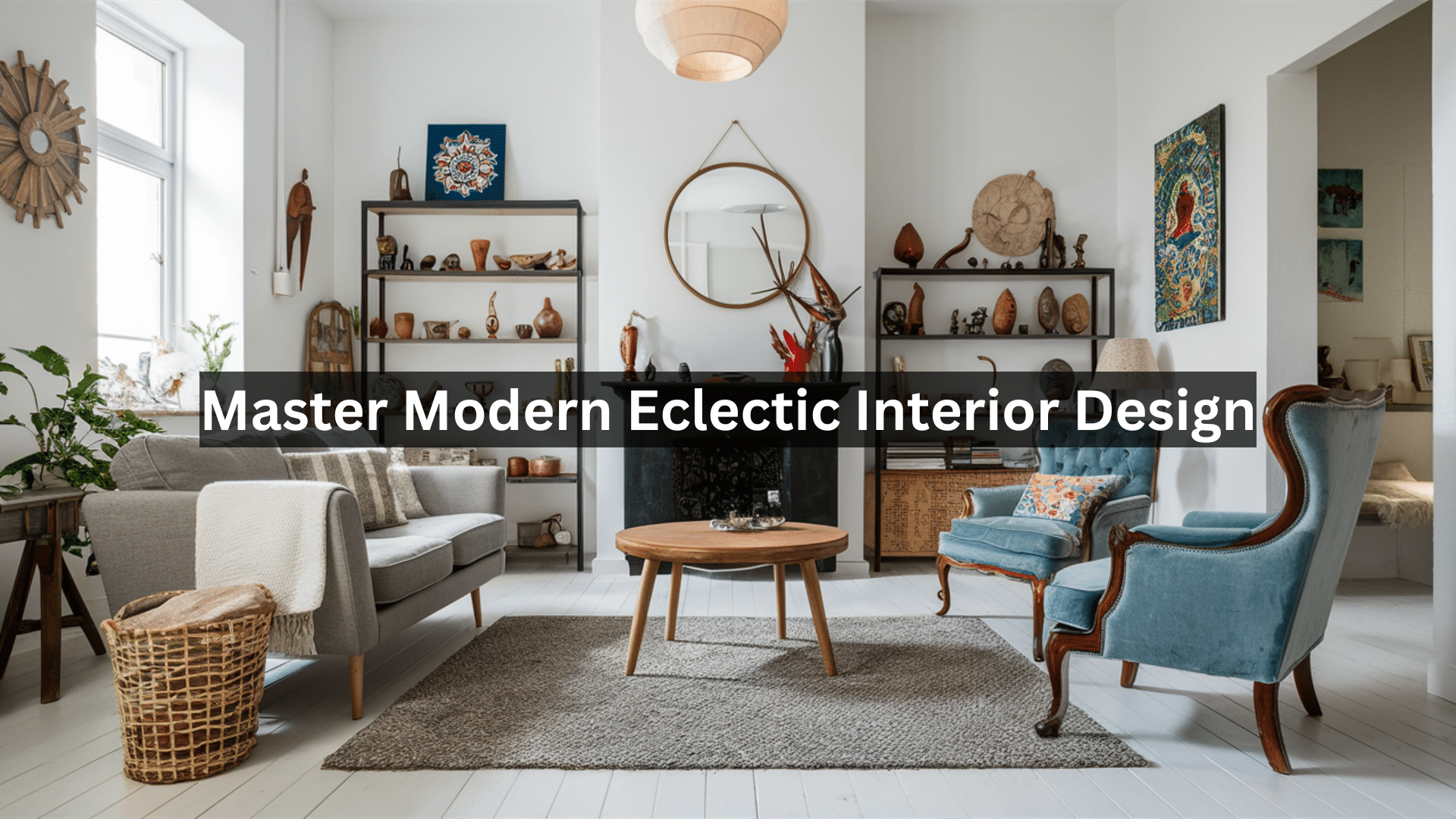Are you struggling to create a home that feels both personal and pulled-together? Modern eclectic interior design might be exactly what you need. In this article, I’ll show you 25 practical ways to mix different styles, eras, and items to create spaces that truly reflect who you are.
I’ve spent years helping people transform their homes from cookie-cutter to custom-made. The methods I share here work for any budget and any space size. These aren’t just theories—they’re tested techniques that have helped hundreds of my clients.
Whether you’re starting from scratch or looking to refresh your current space, you’ll find clear, actionable steps to create a home that feels collected, not decorated.
I promise that by the end of this article, you’ll have the confidence to mix and match with purpose.
What Is Modern Eclectic Interior Design?
Modern eclectic interior design is the thoughtful mix of different styles, eras, and items that somehow work together. It’s not random—there’s intention behind every choice. This style lets you blend modern pieces with items that have history and character.
The result? A space that feels collected over time rather than bought all at once. It’s perfect for people who want their homes to reflect their unique tastes and experiences rather than look like a catalog.
Ways to Master Modern Eclectic Interior Design
1. Mix Vintage with Modern Staples
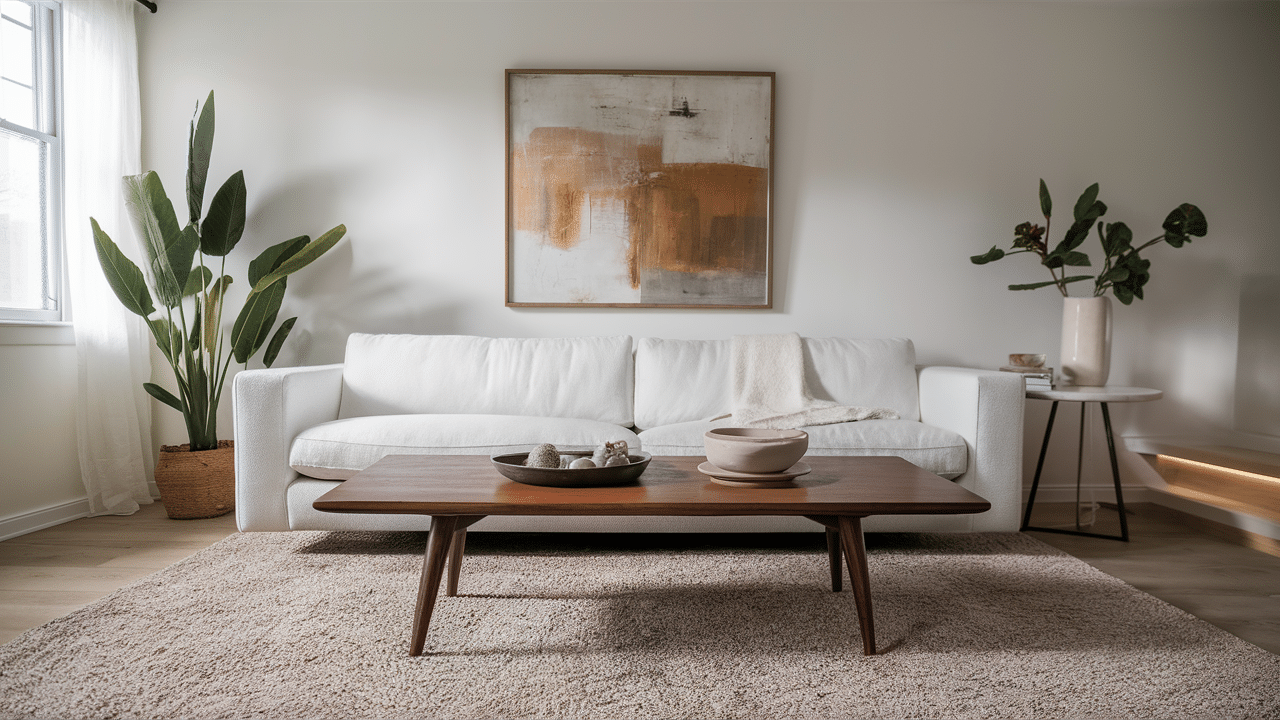
Pairing a sleek, contemporary sofa with a vintage coffee table creates instant interest. The contrast between old and new makes both pieces stand out.
DIY Setup: Find an old wooden side table at a thrift store and sand it down. Paint the legs in a metallic finish while keeping the top natural wood. Place it next to your modern sofa for an instant eclectic mix that costs under $30.
2. Use a Consistent Color Palette for Harmony
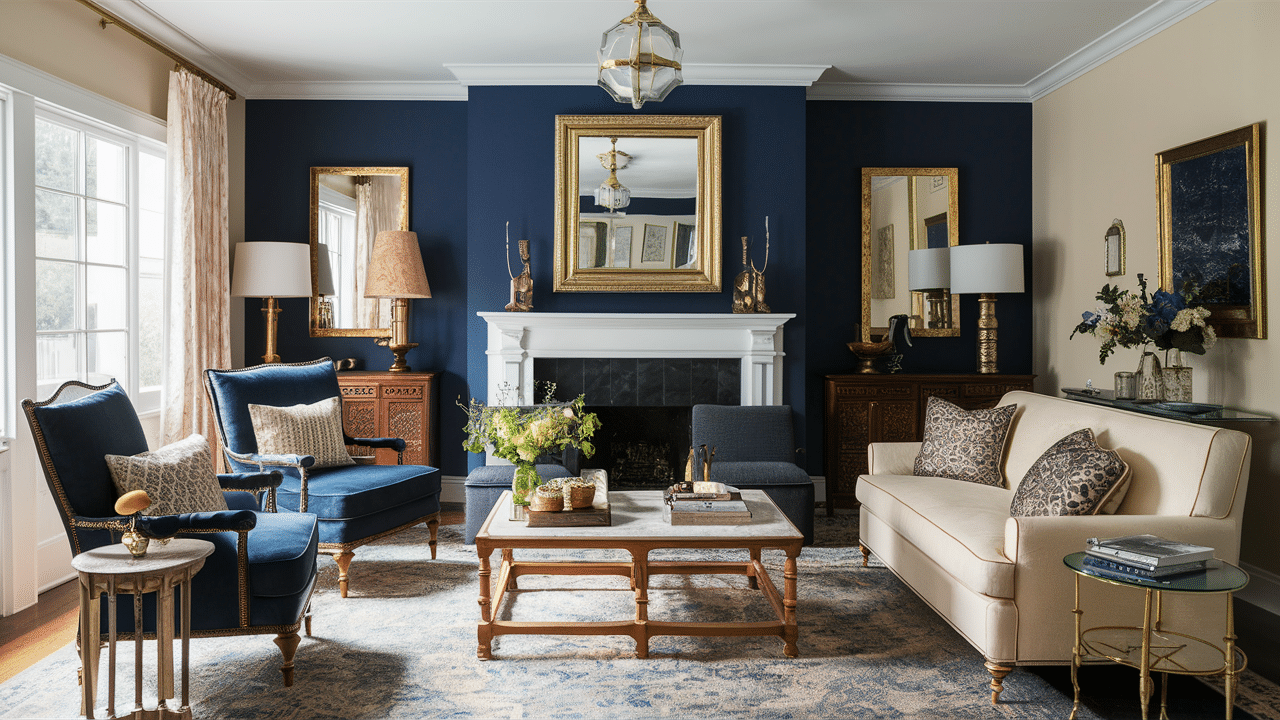
When I work with many different styles, I keep my color scheme tight. Pick 3-5 colors that appear throughout your space. This creates a thread that ties everything together.
DIY Setup: Create a color mood board using paint chips, fabric scraps, and magazine cutouts in your chosen palette. Please keep it on hand when shopping to ensure new items match your scheme.
3. Layer Textures (Think Velvet, Rattan, Leather, and Linen)
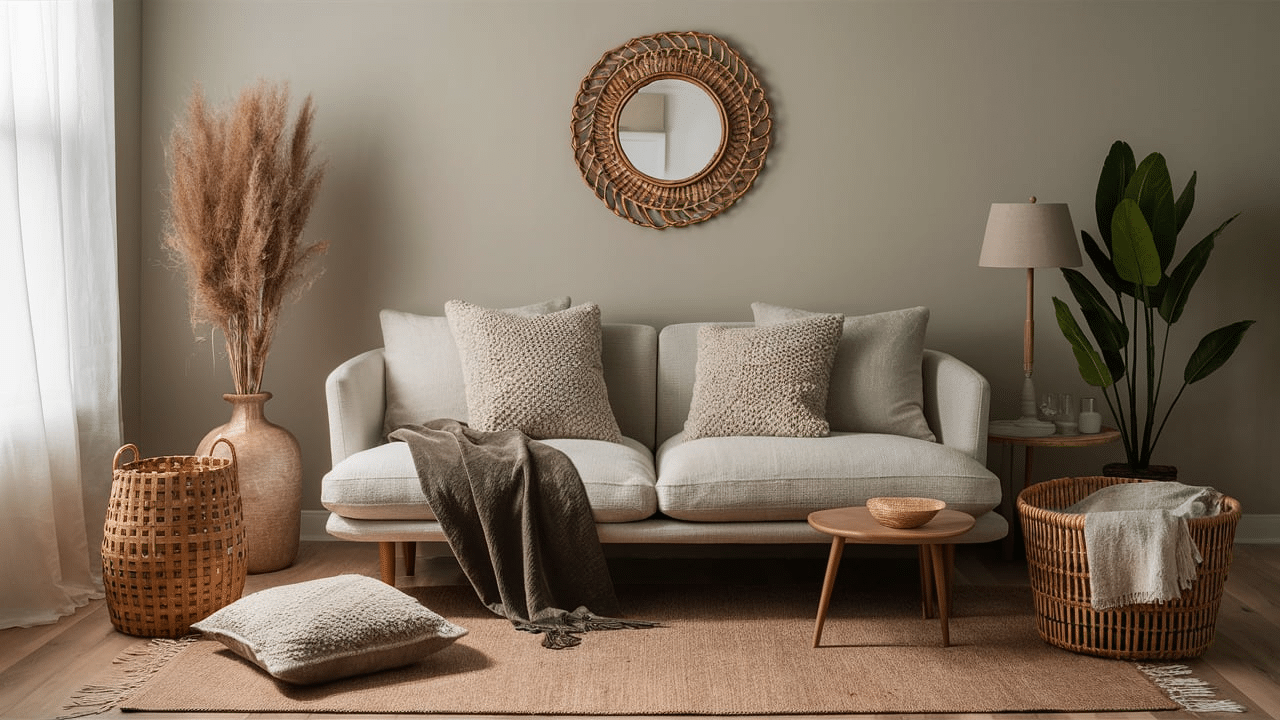
I make my eclectic spaces feel rich by mixing textures. A smooth leather chair looks even better next to a nubby linen pillow. Add a rattan basket, a velvet throw, and a wool rug—suddenly, the room has depth.
DIY Setup: Transform plain cotton pillowcases with textural elements. Add tassels to corners, sew on small patches of velvet, or use fabric paint to create raised patterns.
4. Statement Lighting That Ties the Room Together
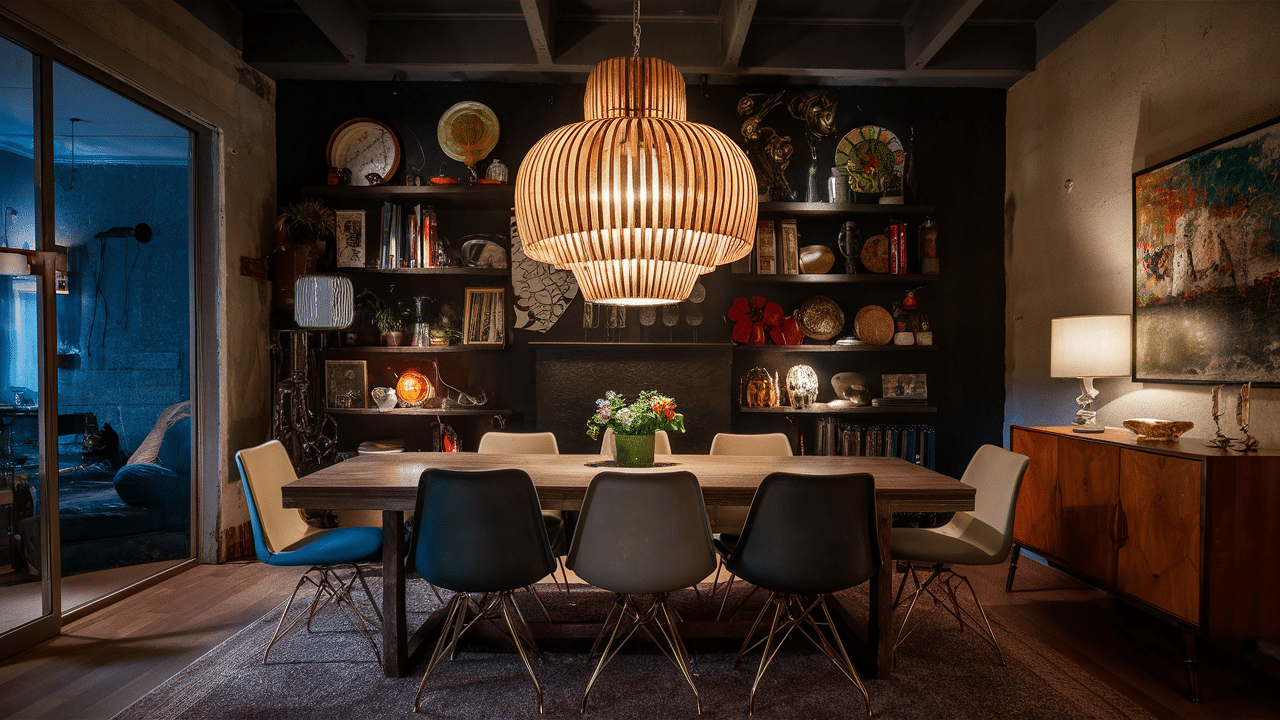
I’ve found that a bold light fixture can unite an eclectic space. Whether it’s a modern pendant or a restored vintage chandelier, make it count. Good lighting draws the eye up and creates a focal point.
DIY Setup: Buy a plain paper lantern and transform it with paint, washi tape, or cut paper designs. Hang it from a simple cord kit from the hardware store.
5. Unexpected Art Pairings
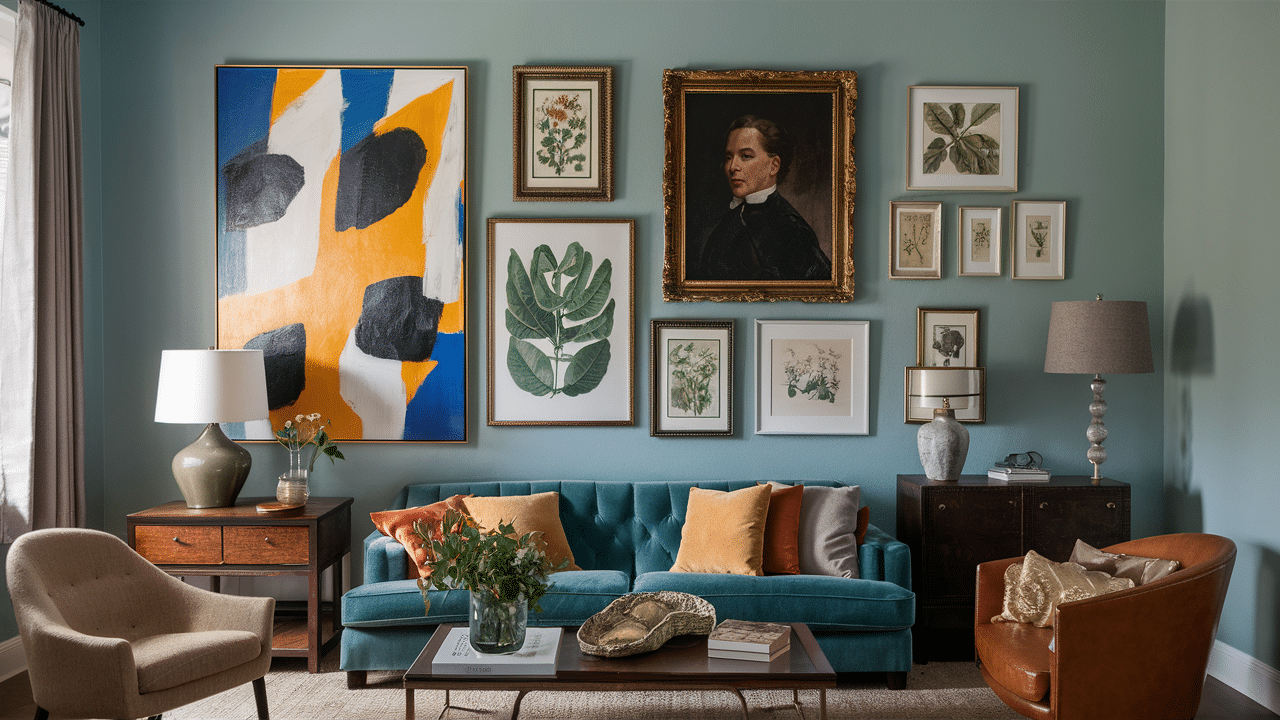
I love to hang a modern abstract painting next to a classic portrait or landscape. This creates what I call “creative tension”—each piece makes you see the other differently.
DIY Setup: Print black and white photos from your phone, then use watercolors to add abstract color blocks over parts of the images. Frame these hybrid creations and hang them alongside more traditional art pieces.
6. Global-Inspired Decor with a Contemporary Twist
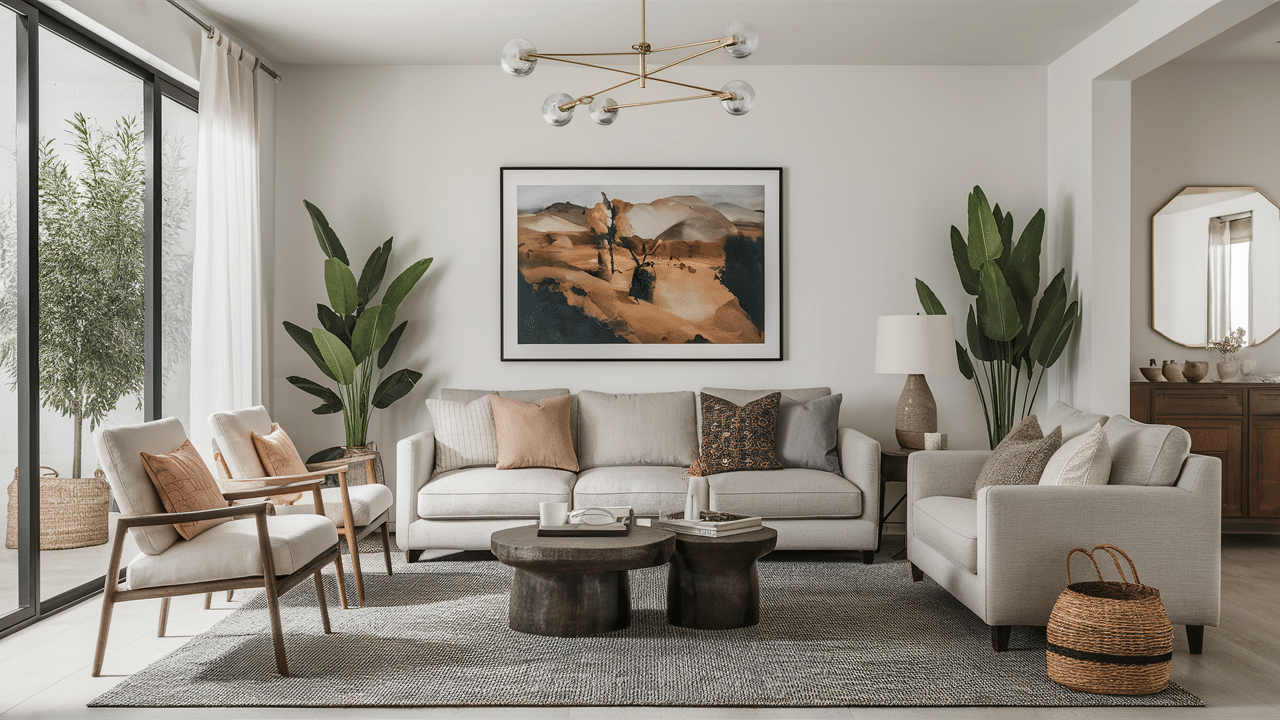
I include items from my travels alongside modern pieces. A handwoven basket from Morocco looks great with clean-lined furniture. The key is finding global items that complement your color scheme and overall feel, not just random souvenirs.
DIY Setup: Create your own “global” textile by using fabric markers to add geometric patterns inspired by different cultures to a plain white cotton throw pillow cover. Look at Indian, African, or South American patterns online for inspiration.
7. Modern Furniture, Eclectic Accessories
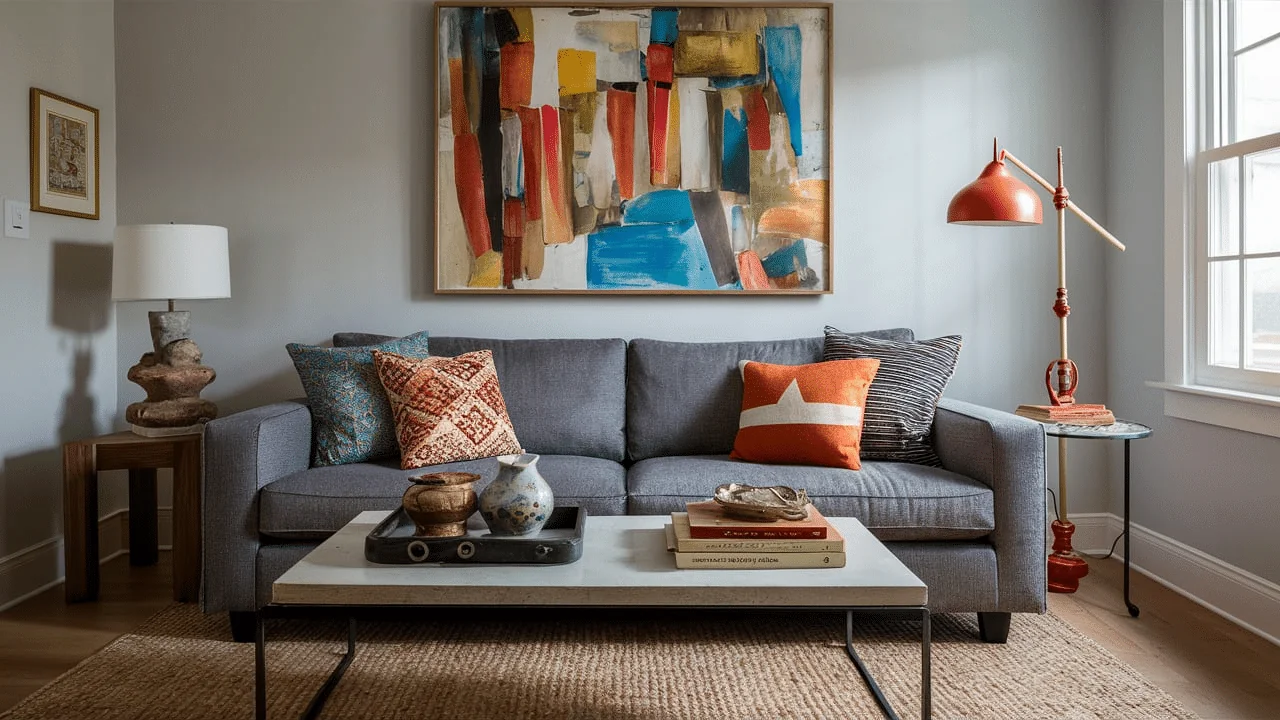
I start with simple, current furniture, then add character through accessories. A basic sofa becomes much more interesting when paired with unique pillows, throws, and small decorative objects. This approach makes it easier to change things up when I want a fresh look.
DIY Setup: Fill mismatched teacups and saucers with melted wax and wicks (kits available at craft stores) to turn them into candles. These unique accessories add character to modern shelving without a major investment.
8. Create a Gallery Wall with Diverse Frames
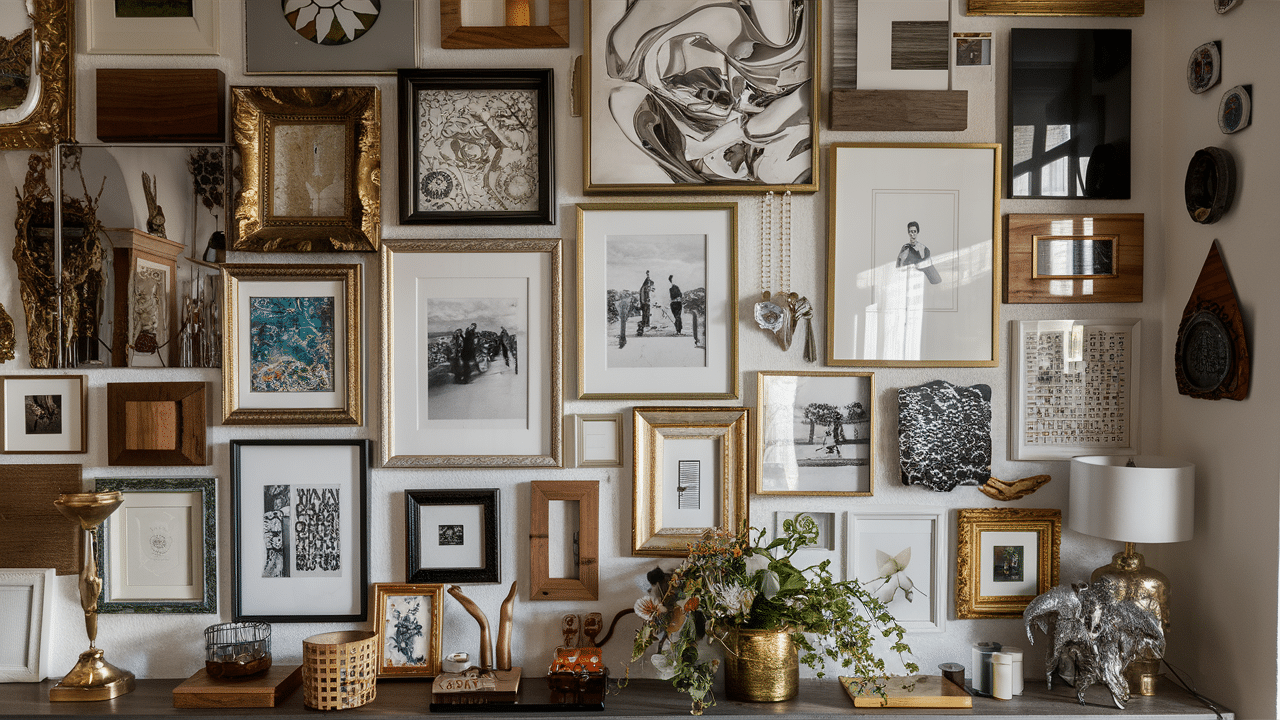
My gallery walls tell stories by mixing frame styles, sizes, and contents. I include family photos, art prints, small objects, and even empty frames. The trick is keeping some element consistent—maybe all black frames but different sizes or all same-sized frames in various finishes.
DIY Setup: Collect thrift store frames of different styles and spray-paint them all the same color. Fill with free printable art, photos, and small pieces of fabric. Arrange them on the floor before hanging them to find the right layout.
9. Use Books as Design Elements
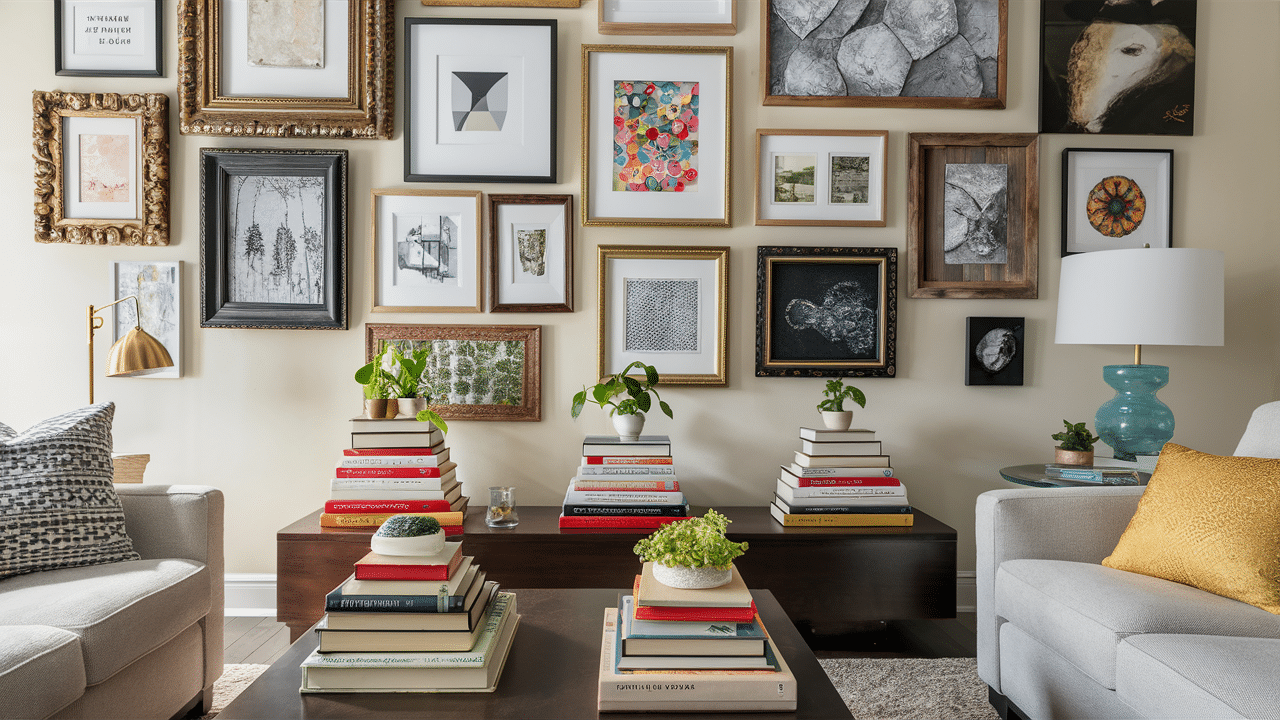
I arrange books by color sometimes and stack them horizontally for height other times. Books add personality and create platforms for small objects. Plus, they tell visitors what interests them. I keep some stacked on coffee tables, others on shelves, and a few special ones displayed open.
DIY Setup: Find old hardcover books with interesting spines at garage sales. Remove the dust jackets to reveal the often beautiful covers underneath. Stack three to five books of graduated sizes to create a display stand for a small plant or decorative object.
10. Add an Antique Rug to Ground the Space
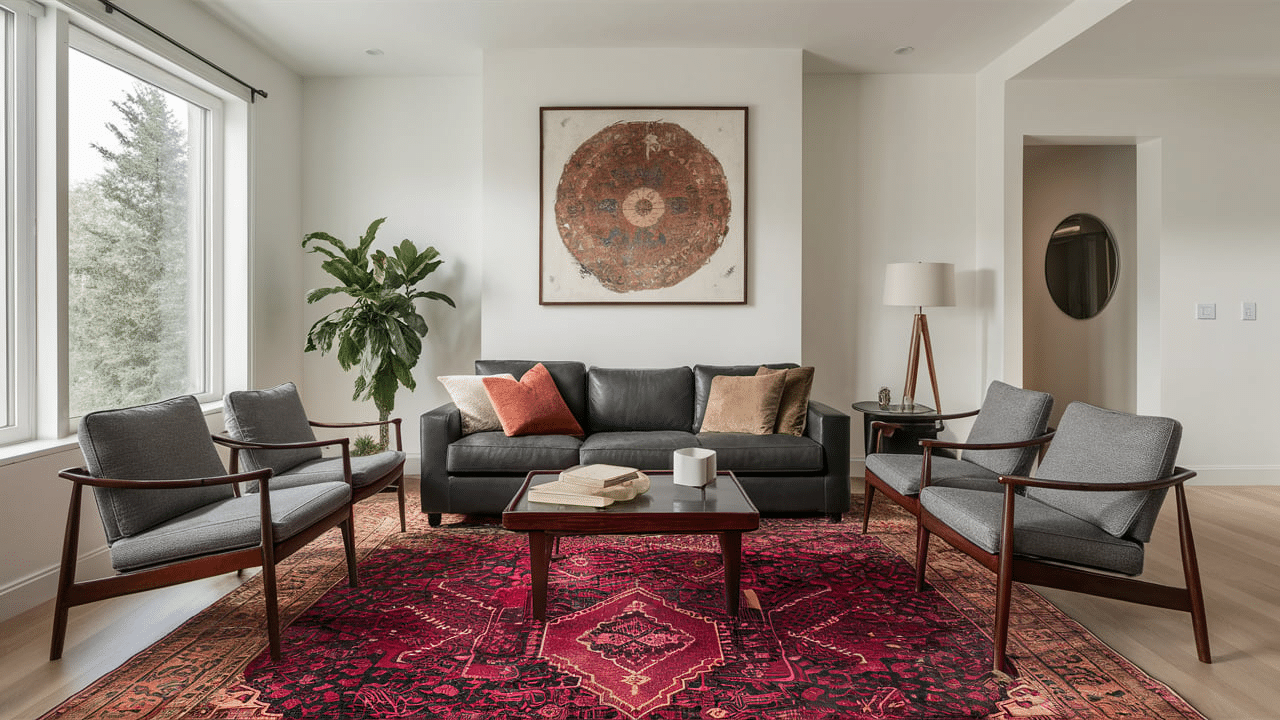
An older rug with some wear adds warmth to modern rooms. The patina and subtle fading of an antique carpet bring soul to clean-lined furniture. It doesn’t need to be expensive—look for interesting patterns and colors that work with your scheme.
DIY Setup: If you find a worn vintage rug with damaged areas, use fabric paint to touch up faded colors or stitch colorful yarn over worn spots. These imperfections add character and story to your space while saving money on a perfect specimen.
11. Combine Minimalist Layouts with Maximalist Touches
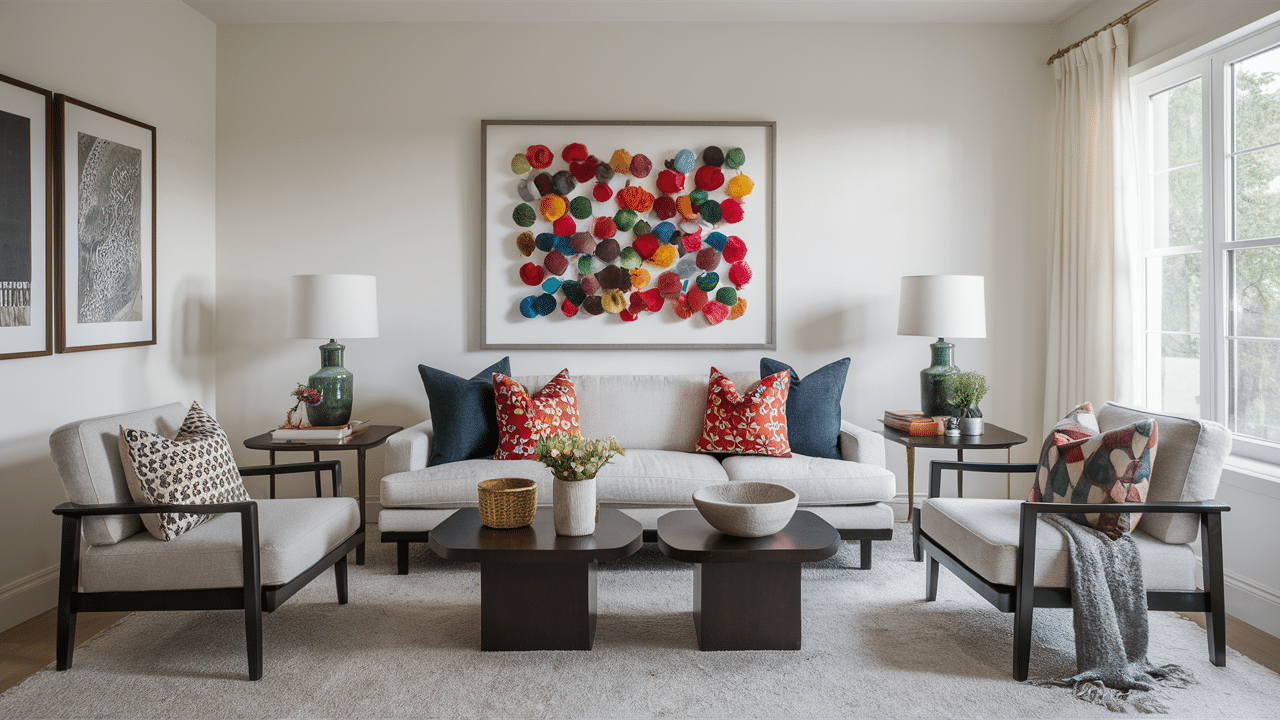
I like to keep my furniture layout simple and uncluttered, then add interest with bold accessories. This balance prevents the eclectic from becoming chaotic. For example, a clean-lined sofa and chair arrangement topped with colorful pillows and throws creates the perfect tension.
DIY Setup: Line a simple wooden tray with vibrantly patterned contact paper or wallpaper scraps. Fill it with collected small objects like crystals, shells, or miniatures. This contained display adds a maximalist punch to a minimal coffee table.
12. Feature One Bold Pattern, Then Layer Subtle Ones
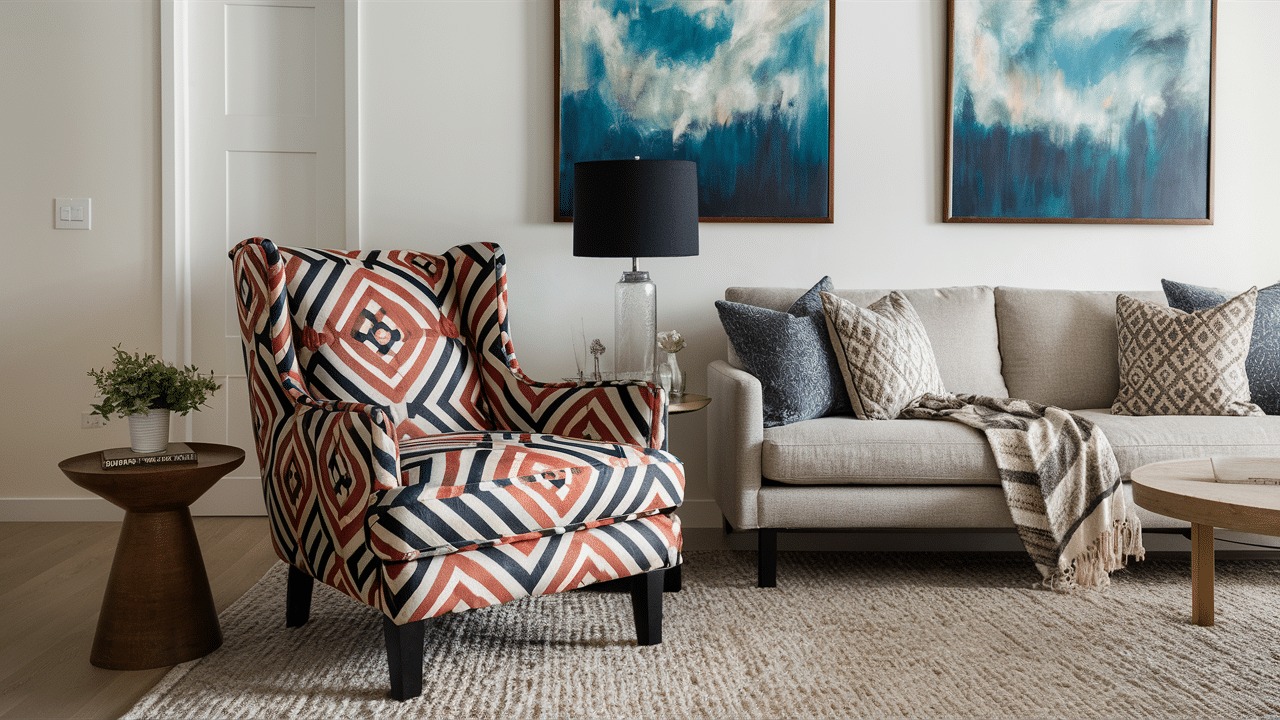
I choose one statement pattern—maybe on curtains or a chair—then add quieter patterns that share colors with the bold one. This creates depth without confusion. Think of a striking floral chair paired with subtle striped pillows and a small-scale geometric throw.
DIY Setup: Buy a yard of bold fabric and cover the top of a simple ottoman or stool with it. Then, use fabric markers to add simple stripes or dots to throw pillow covers in complementary colors. This creates a coordinated pattern story for under $50.
13. Color-Blocking with Intent
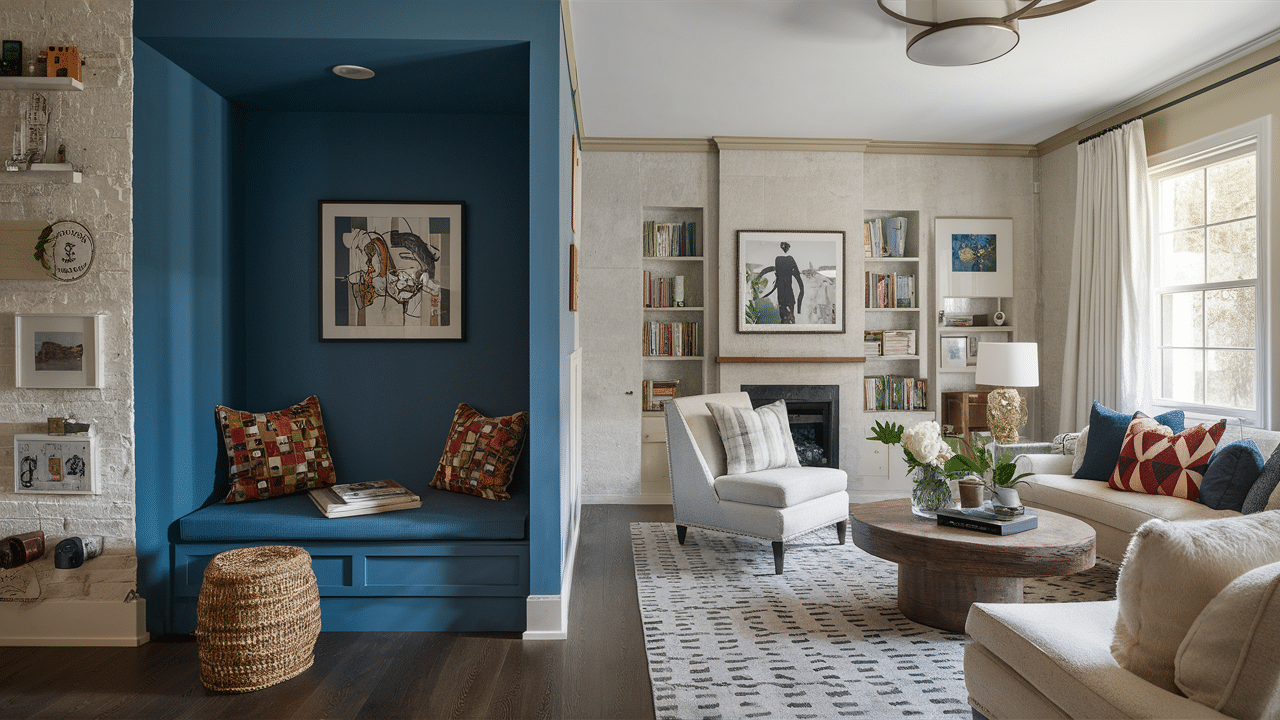
I use blocks of color to define zones in a room. A blue reading nook next to a neutral conversation area helps make sense of different furniture styles. This technique creates order within the eclectic mix while adding visual interest.
DIY Setup: Paint a large piece of plywood with your accent color and lean it against the wall behind a chair to create a color block without painting the walls. Add a matching throw and lamp to complete the zone—perfect for renters who can’t paint.
14. Accent Walls Using Wallpaper or Mural Art
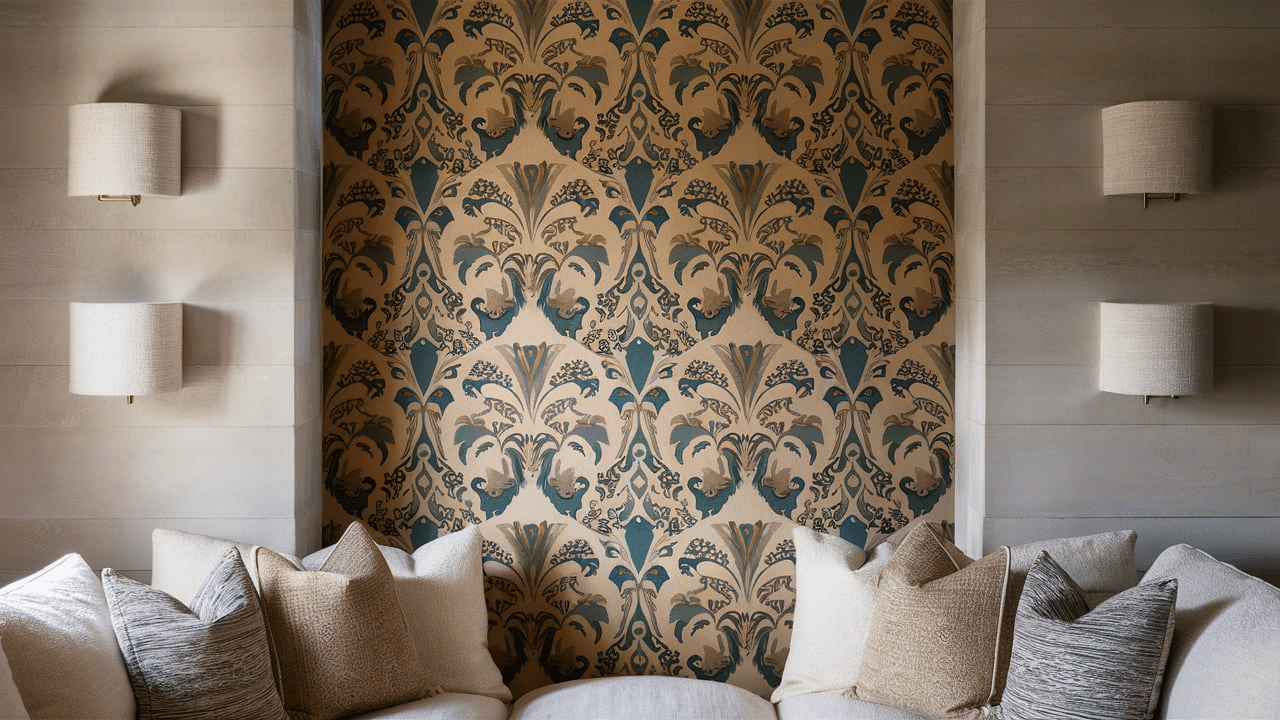
I love how a single wall with bold wallpaper or a mural can pull an eclectic room together. It provides a backdrop that helps diverse pieces make sense together. For best results, choose a design that includes colors found in your furniture and accessories.
DIY Setup: Create a temporary accent wall using washi tape to make geometric patterns directly on a painted wall. This no-commitment approach lets you experiment with bold designs and is completely removable for renters or the design-fickle.
15. Blend Metallics: Brass, Gold, Black Iron
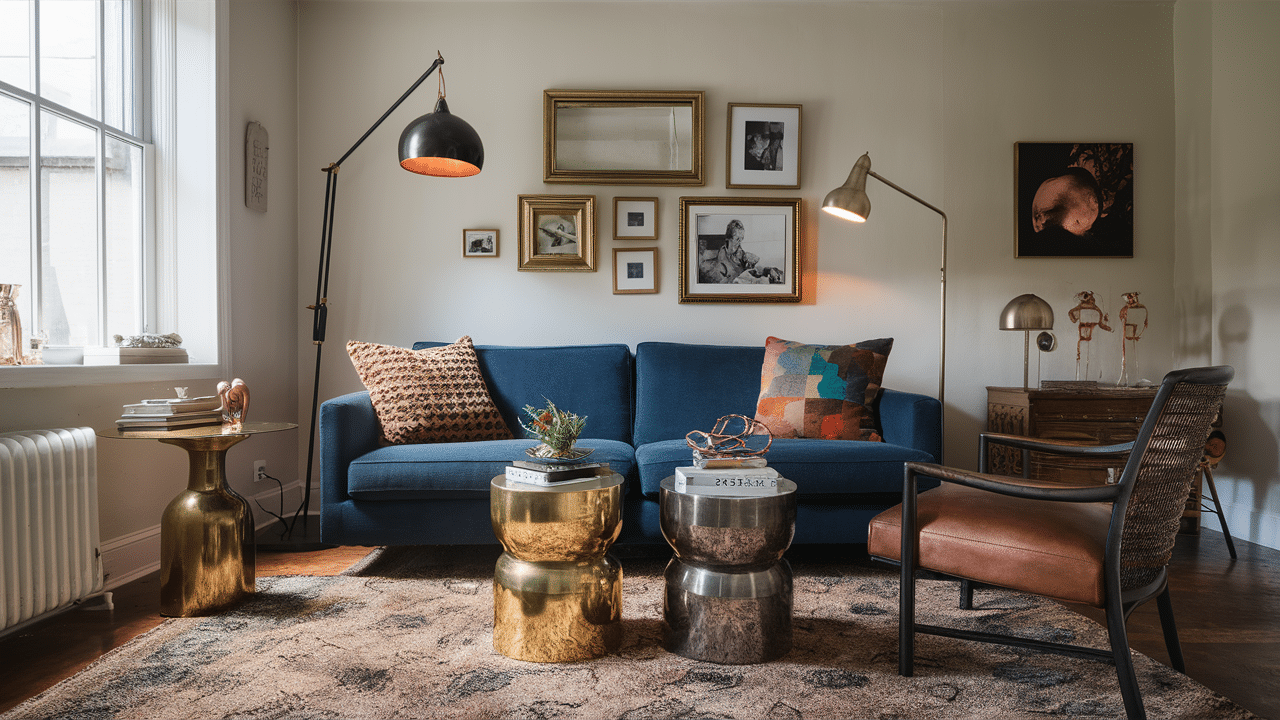
I mix metal finishes throughout my spaces. An iron floor lamp, a brass coffee table, and chrome picture frames can coexist beautifully. The trick is to repeat each metal at least twice in the room so they look intentional rather than random.
DIY Setup: Collect empty food cans in various sizes, clean them thoroughly, and spray-paint them in different metallic finishes. Use as planters, pencil holders, or vases grouped on a shelf. This creates a cohesive mixed-metal display for just the cost of the paint.
16. Showcase Personal Collections (Ceramics, Travel Finds, etc.)
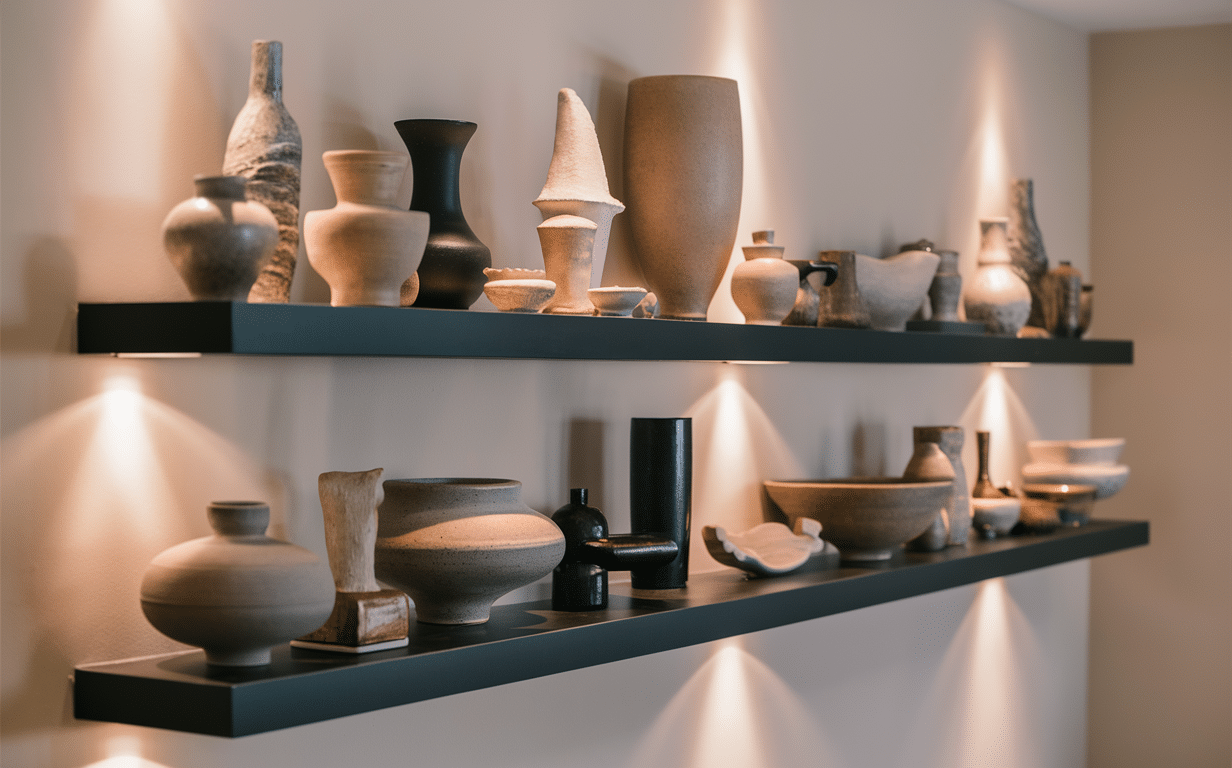
I grouped similar objects for impact. My collection of blue ceramics looks much more striking when displayed as a group than scattered around. Collections tell your story and add a personal touch that can’t be replicated from a store.
DIY Setup: Install a simple floating shelf dedicated solely to your collection. Paint the shelf the same color as your wall so the items appear to float. Add small LED puck lights above to highlight special pieces—this professional-looking display costs less than $50.
17. Play with Shape—Arches, Curves, and Abstract Forms
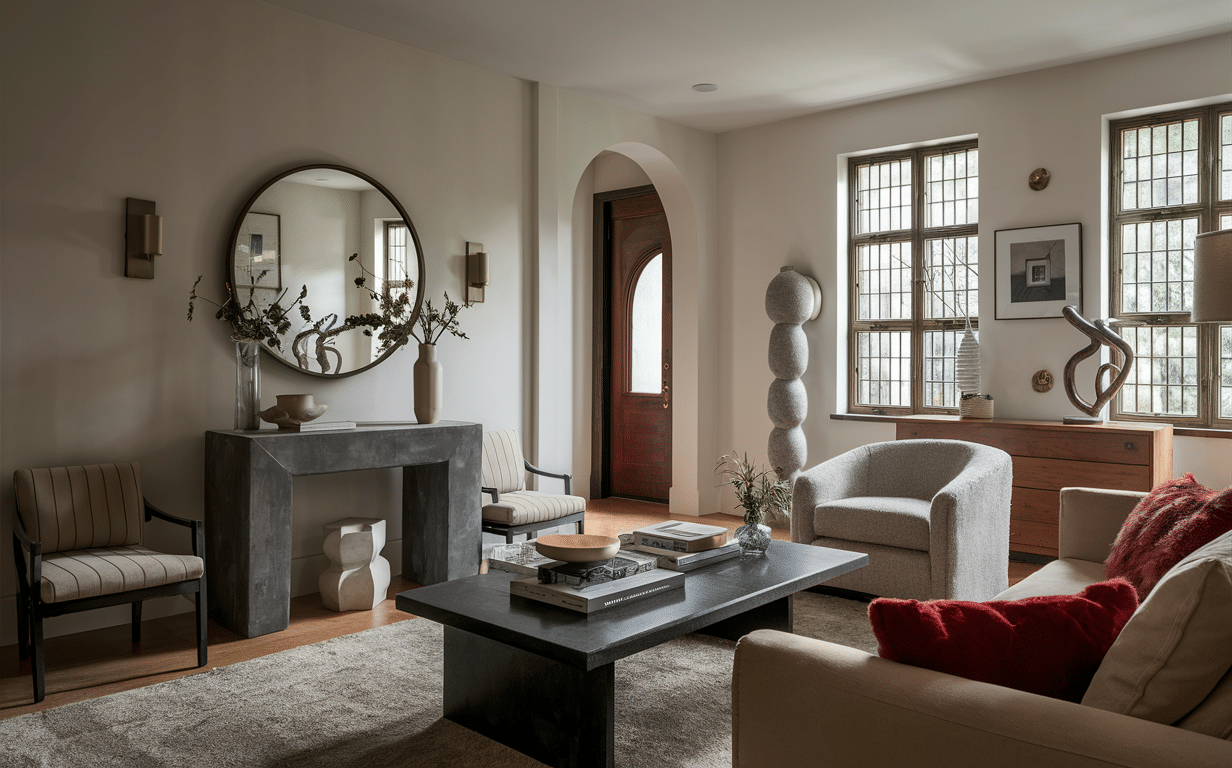
I added interest by mixing geometric shapes. A round mirror above a rectangular console topped with sculptural objects creates visual rhythm. Look for opportunities to include curves in a room full of straight lines or vice versa.
DIY Setup: Cut arch shapes from cardboard, cover with textured wallpaper samples or fabric, and mount on the wall as abstract art pieces. Create three to five in different sizes and hang them in a loose arrangement for a high-end look at craft-project prices.
18. Mix High-End Pieces with Budget Finds
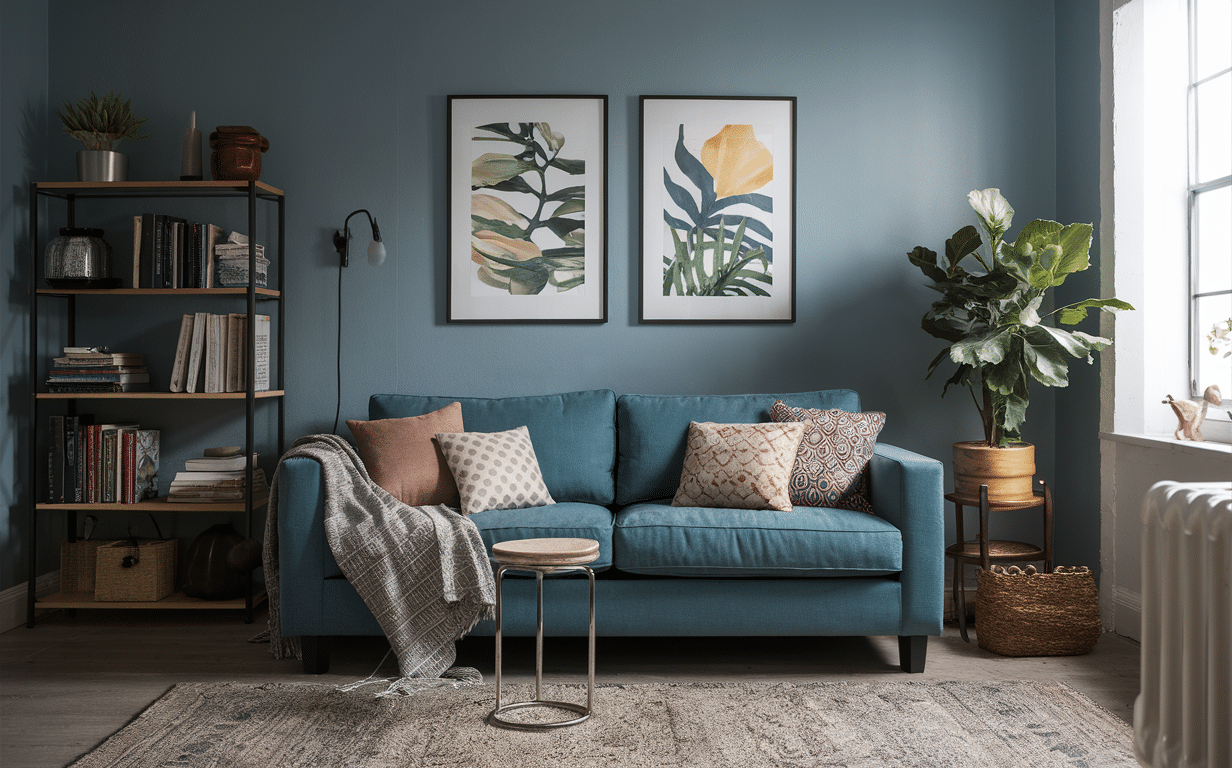
I might spend on a quality sofa and pair it with a side table from a thrift store. This high-low mix feels more authentic than when everything is expensive. The key is choosing budget items with good lines and shapes—they’ll stand up to the higher-end pieces.
DIY Setup: Transform a basic side table from a big box store by adding furniture legs with more character. Most hardware stores sell interesting wooden legs for $5-$15 each. This simple swap elevates a budget piece to look custom beside your quality furniture.
19. Balance Asymmetry with Visual Weight
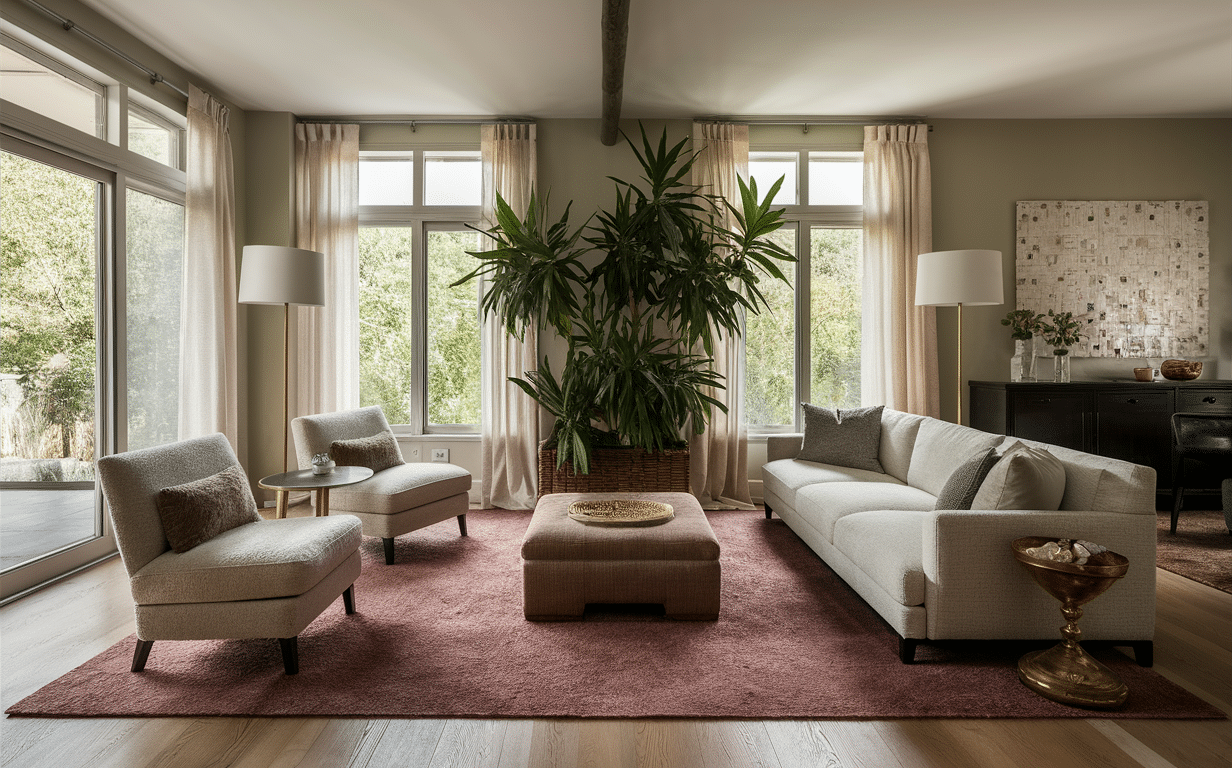
I create balanced rooms even when the pieces don’t match. A large sofa on one side might be balanced by two smaller chairs and a plant on the other. It’s about the feeling of equilibrium, not perfect symmetry.
DIY Setup: Draw a simple bird’ s-eye diagram of your room on graph paper. Cut out shapes representing your furniture pieces from colored paper. Experiment with different arrangements to find an asymmetrical balance before moving any actual furniture.
20. Add a Touch of the Unexpected—Like Neon or Vintage Tech
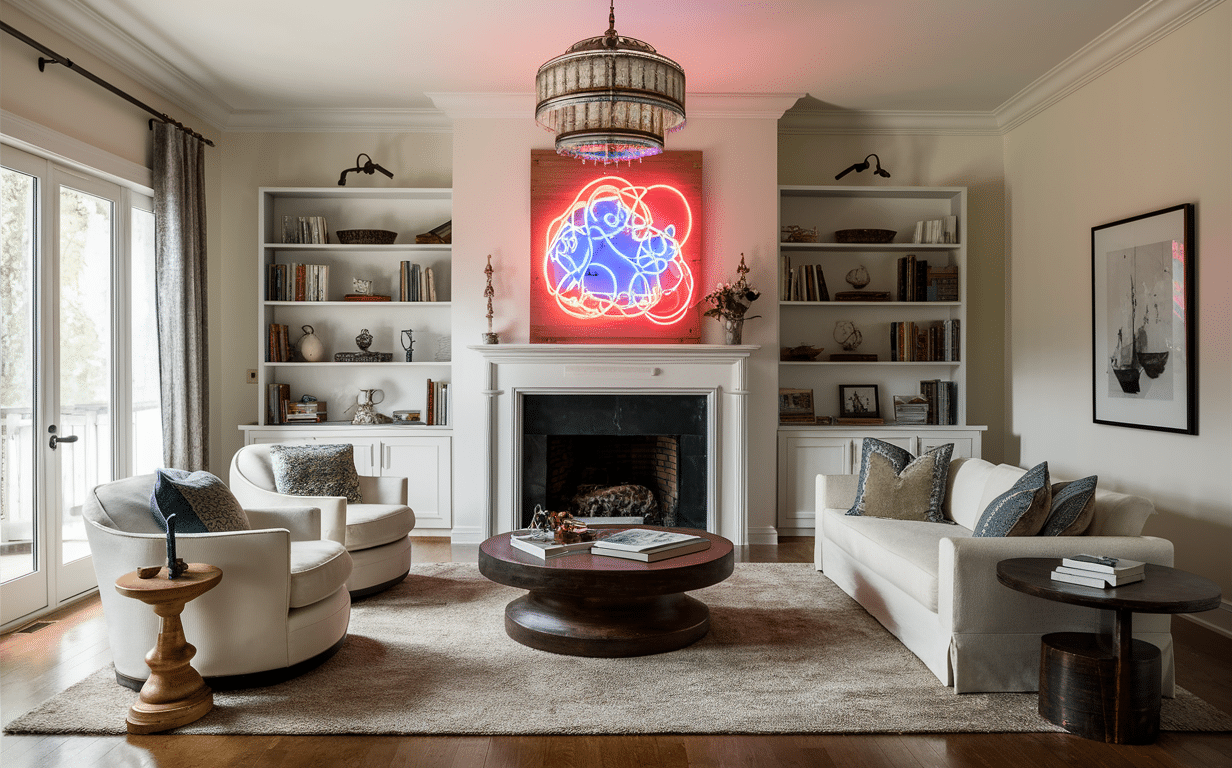
I love to include one truly surprising element—maybe a neon sign in an otherwise traditional space or a vintage record player in a modern room. This unexpected touch becomes a conversation starter and shows personality.
DIY Setup: Create a fake neon sign effect by bending colored EL wire (available online) into a word or shape that means something to you. Mount it on a simple backing and hang as art. This gives the neon effect without the high cost of real neon.
21. Use Mirrors to Reflect Eclectic Energy
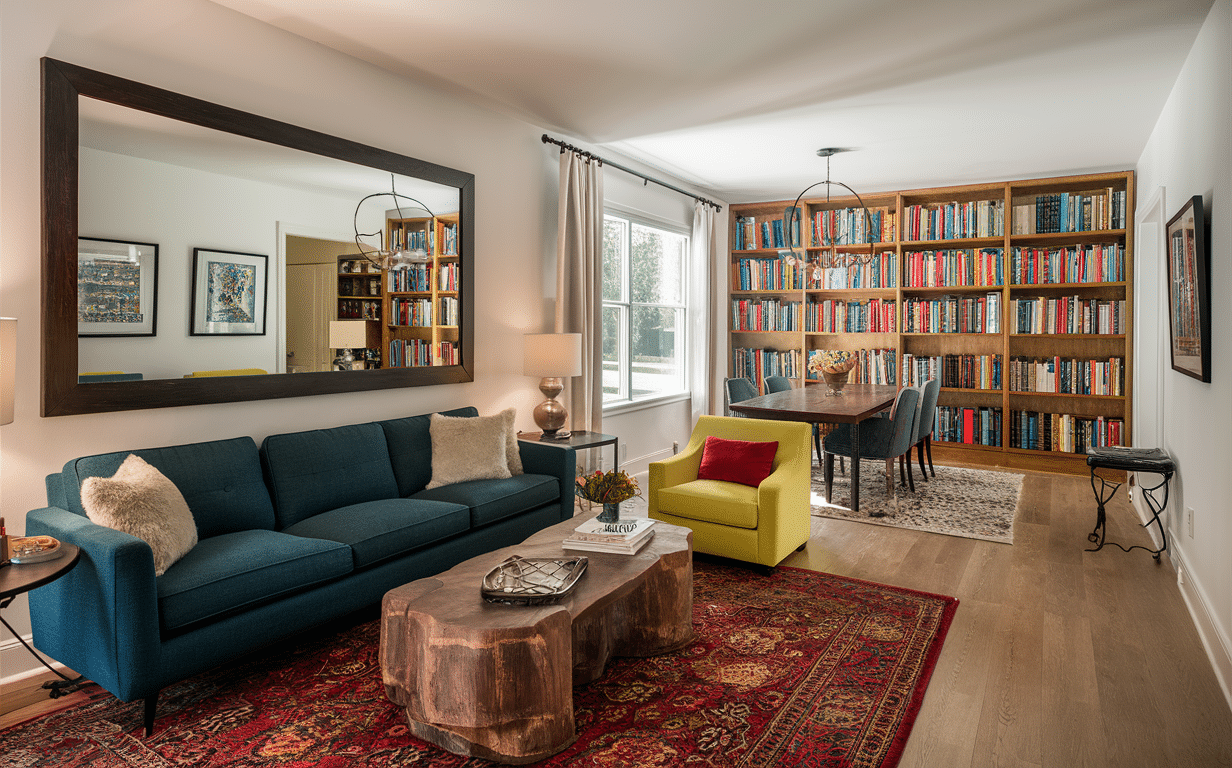
I strategically placed mirrors to bounce light and repeat interesting elements in the room. A mirror across from a colorful bookshelf effectively doubles your visual interest. Look for mirror frames that add to your style mix—ornate, minimal, or something in between.
DIY Setup: Buy plain circular mirrors in various sizes and create your frames using rope, painted cardboard, or washi tape. Group them on a wall opposite your most colorful room feature so they reflect those elements into the space.
22. Create Coziness with Layered Lighting
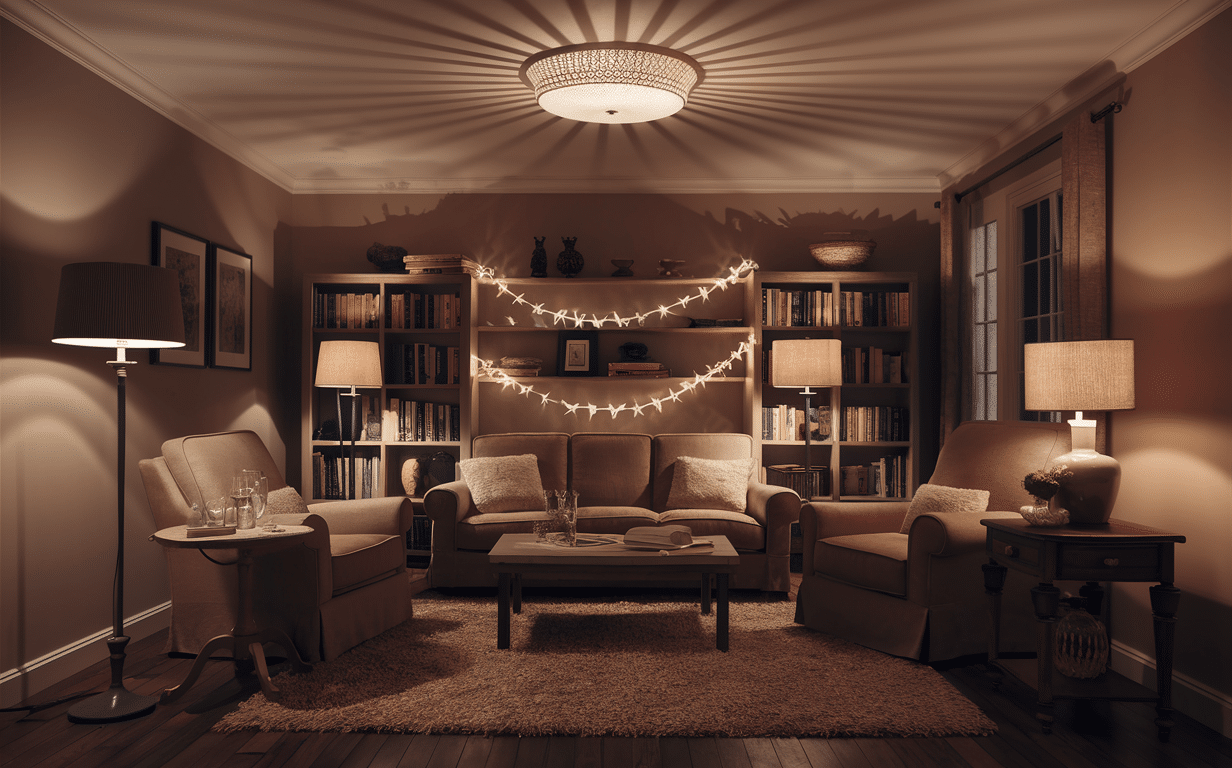
I use multiple light sources at different heights. Table lamps, floor lamps, sconces, and overhead lighting create a warm glow and highlight other areas. This layered approach lets you change the mood by switching different lights on or off.
DIY Setup: String fairy lights inside a large glass jar or vase to create a soft ambient light source. Place several of these at different heights around a room for a magical glow that doesn’t require any electrical work or expensive fixtures.
23. Keep One Room Element Ultra-Minimal to Anchor the Design
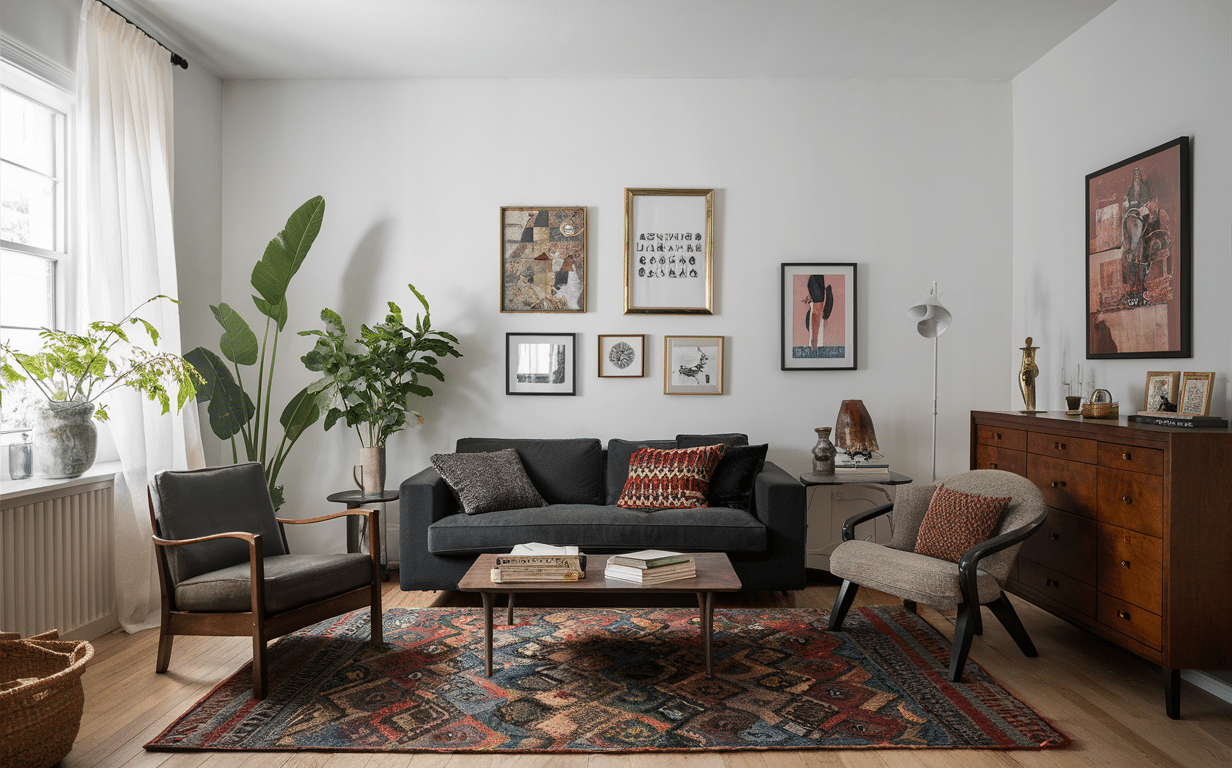
I make sure at least one aspect of my room is very simple—maybe clean white walls or a neutral sofa. This creates breathing room for the eye amid the eclectic mix. Without this anchor, the eclectic can tip into chaos.
DIY Setup: Paint a large piece of plywood white and lean it against a wall to create a clean backdrop for your eclectic items. Use this as a photography-style backdrop to display smaller items. The stark simplicity makes eclectic items pop.
24. Seasonal Swaps for Easy Eclectic Updates
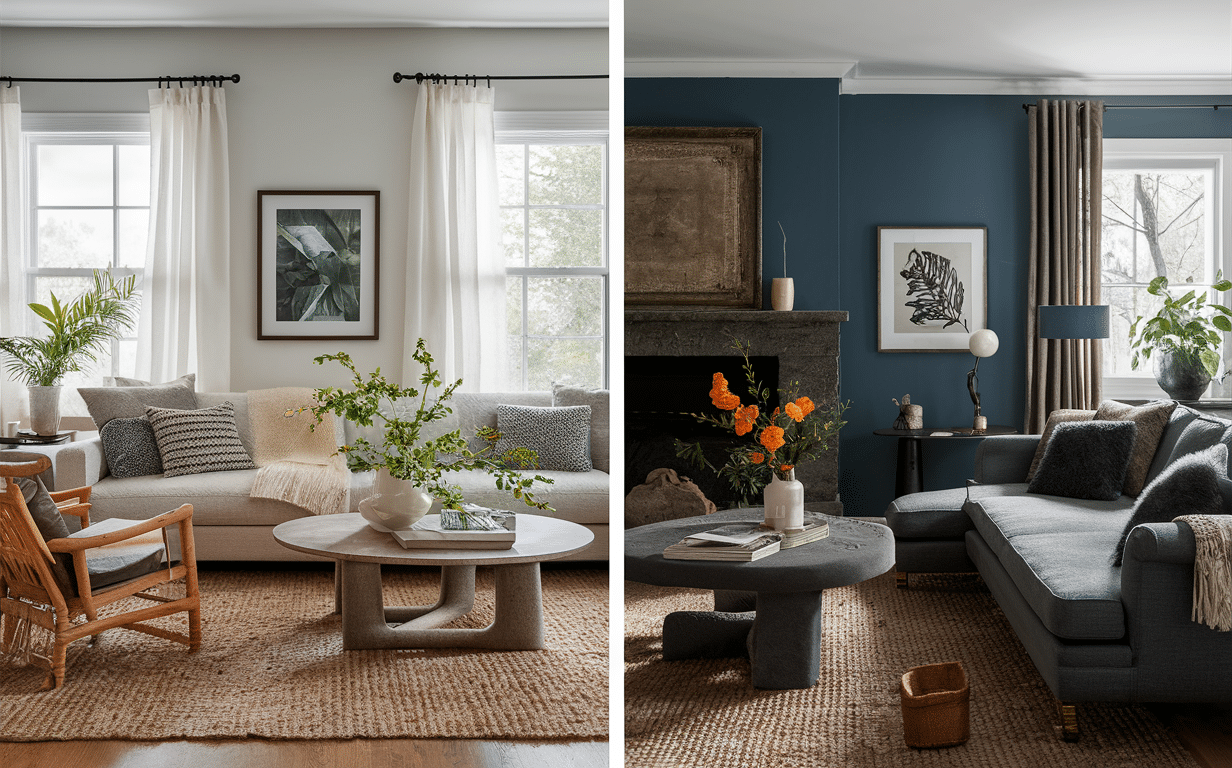
I change small elements seasonally to keep my space fresh. For example, lighter throw pillows and botanical prints in summer might be appropriate, while heavier textures and warmer tones in winter would be appropriate. These simple swaps keep an eclectic space feeling current.
DIY Setup: Create a “seasonal swap box” for each season with appropriate textiles and small decor. Press flowers in summer to frame for fall; collect pinecones in fall to display in winter. This organized approach makes seasonal changes easy and cost-effective.
25. Trust Your Instincts and Curate with Meaning
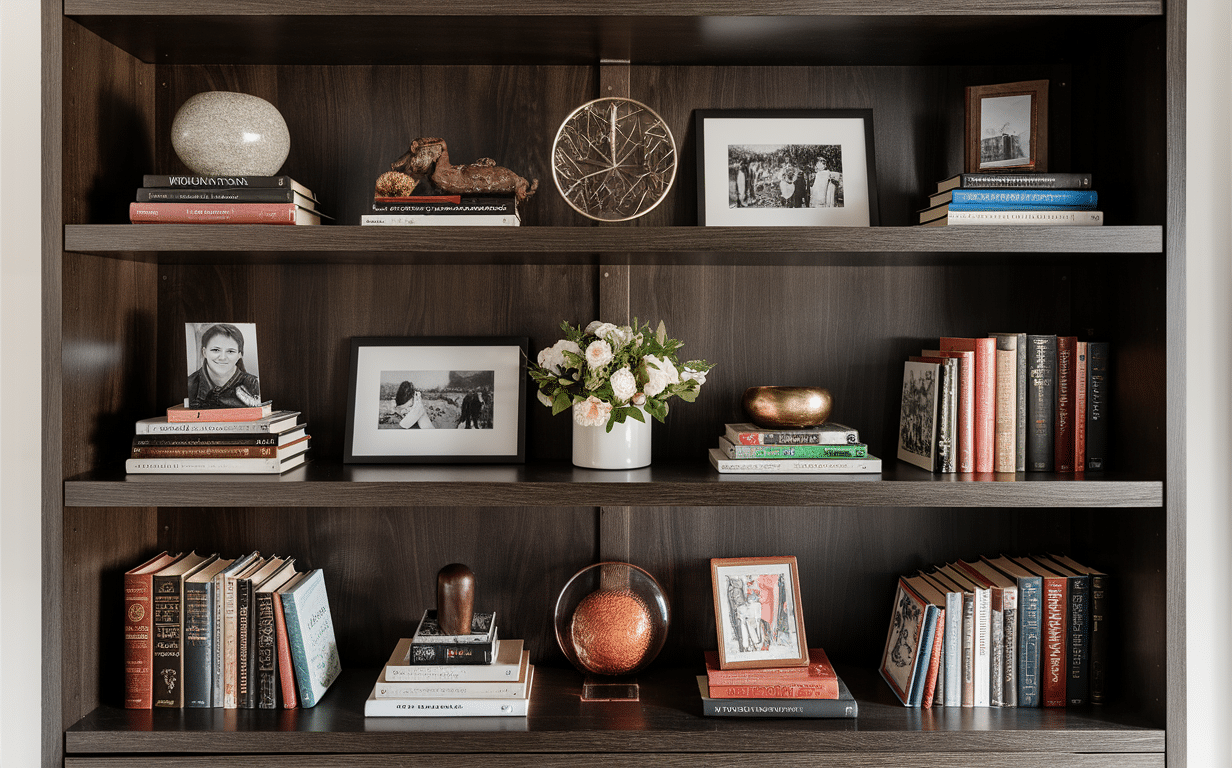
I only include items I truly love or that serve a purpose. Eclectic design works best when it reflects your authentic self, not just random things. If a piece speaks to you or holds meaning, it will likely work in your space when combined thoughtfully.
DIY Setup: Create a simple “curation corner” in your home—a small table where potential new items sit for a week before you decide to keep them. If you still love them after a week and can think of where they’ll go, they earn a permanent spot in your eclectic mix.
How to Keep Your Eclectic Space Cohesive
The biggest challenge with eclectic design is keeping it cohesive. I’ve found that repeating colors throughout a space is the easiest way to create unity. I also maintain similar wood tones where possible.
Another trick is to group items by theme or color before spreading them throughout a room—this creates subtle connections for the eye to follow. Most importantly, I edit regularly. Just because eclectic design embraces mixing doesn’t mean everything belongs. Each item should earn its place.
Common Mistakes to Avoid in Eclectic Design
Several pitfalls can turn your carefully curated mix into a confusing mess when creating an eclectic space.
First, avoid buying everything at once. Eclectic spaces should feel collected over time. Rushing to purchase an entire room in one shopping trip makes it look staged rather than authentic.
Second, beware of going too theme-heavy. While thematic elements can guide your choices, an overly literal interpretation feels forced. Instead, aim for subtle nods to your inspirations.
Third, don’t forget about scale. Mixing furniture of widely different proportions can create visual chaos. Pay attention to the height, width, and visual weight of pieces.
Fourth, resist the urge to display everything you own. Eclectic doesn’t mean cluttered. Edit ruthlessly and rotate collections. Remember that negative space is crucial for allowing your special items to shine.
Finally, don’t neglect the basics of good design in pursuit of eclecticism. Proper lighting, comfortable traffic flow, and functional furniture arrangements still matter.
Conclusion
Mastering modern eclectic design is about finding your unique style voice through thoughtful combinations. Your home should tell your story—where you’ve been, what you love, and who you are. The beauty of this approach is that it grows with you, never becoming dated or stale.
The key to success lies in balance—mixing old with new, bold with subtle, and expensive with budget-friendly. Keep a few unifying elements like color, shape, or texture to hold everything together. Edit regularly, and be honest about what truly speaks to you.
Remember that the best eclectic spaces evolve slowly over time. Don’t rush the process. Each carefully chosen piece adds another layer to your home’s personality. In the end, your space should make you feel both energized and comfortable—that’s the magic of eclectic design.
Frequently Asked Questions
How Can I Create an Eclectic Look if I’m Renting and Can’t Paint or Make Permanent Changes?
Use large fabric panels, removable wallpaper, and free-standing furniture groupings to create zones and interest without altering the space. Textiles and lighting make a huge impact with zero commitment.
What’s the Biggest Mistake People Make with Eclectic Design?
They confuse “random” with “eclectic.” True eclectic spaces have thoughtful connections between items—shared colors, complementary shapes, or thematic links that create harmony amid diversity.
How Do I Incorporate Family Heirlooms Into a Modern, Eclectic Space?
Place traditional pieces in unexpected contexts—a vintage chair at a modern desk or an antique mirror in a minimalist bathroom. The contrast honors the piece while keeping the overall vibe fresh.
Is Eclectic Design Possible in Small Spaces?
Absolutely! In fact, eclectic design can make small spaces more interesting. Just keep the color palette tighter, focus on multi-functional pieces, and be extra selective about what you include.
How Often Should I Refresh My Eclectic Space?
Instead of complete overhauls, make micro-changes seasonally and move things around yearly. Eclectic spaces should evolve naturally rather than following trend cycles.

